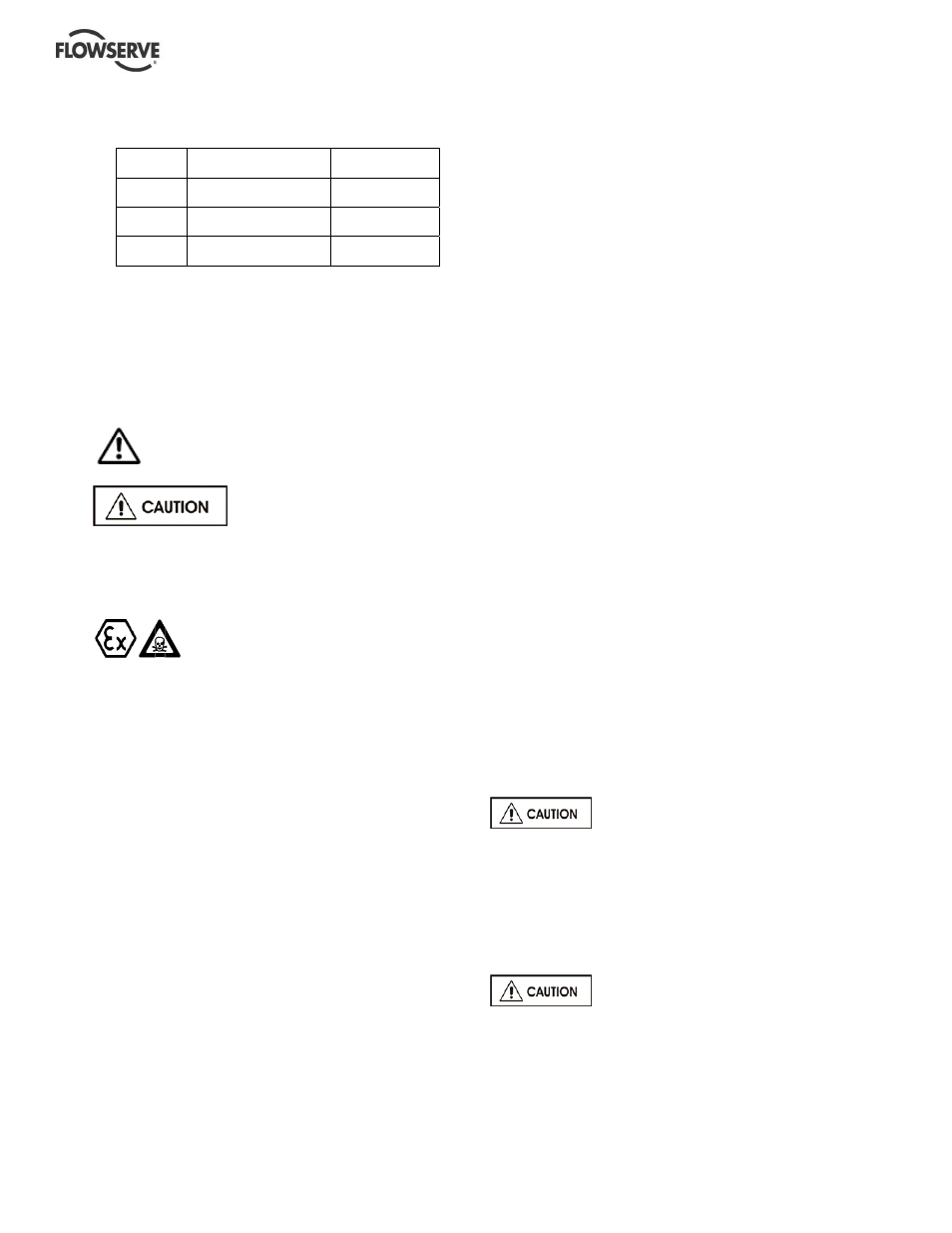Setting impeller clearance 6.7, Disassembly 6.8, Examination of parts 6.9 – Flowserve VTP Wet Pit User Manual
Page 51

VERTICAL TURBINE PUMPS (VTPS) CENTRIFUGAL PUMPS ENGLISH 71569224
– 10-13
Page 51 of 76
flowserve.com
Torques for couplings screws
6.6.2
Coupling
size #
Flange diameter
mm (in.)
Nm
(lbf·ft)
1 & 2
111 or 137
(4.4 or 5.4)
122
(90)
3-5
156, 187 213
(6.0, 7.4, 8.4)
237
(175)
6 250
(10.0)
424
(313)
Torque values are for standard fasteners lubricated with a high
stress lubricant (such as, graphite and oil, moly-disulphite, white lead
etc.). For stainless steel bolts, multiply listed torques by 0.80.
Setting Impeller Clearance
6.7
Please see section 5.3 for specific instructions on
impeller adjustment.
Disassembly
6.8
Refer to section 1.6, Safety, before
dismantling the pump.
Before dismantling the pump for
overhaul, ensure genuine Flowserve replacement
parts are available.
Refer to sectional drawings for part numbers and
identification.
Please take precaution during
disassembly that there is no risk of explosion due to
the nature of the materials/ tools/ equipment/ method
used. Wherever chemical and hazardous materials
are involved, proper safety rules have to be followed
to prevent any dangers to human lives or livestock.
Contact Flowserve for guidance, or local regulatory
agency for specific safety information.
Pump disassembly instructions
6.8.1
See section 8 for sectional drawings.
a) Disconnect all cables/wires and cooling water
pipe connections to the driver (if provided).
b) Carefully remove the flush or lubricant
connections and remove any associated piping
that would interfere with the dismantling.
c) Make sure that all the valves are shut completely
to avoid any leaks or spills.
d) Disconnect the coupling halves [471] (the driver
& pump).
e) Disconnect the suction (if used) and discharge
pipe connections to the discharge head.
f) Rig the motor to a suitable hoist and keep the
lifting mechanism in ready state.
g) Remove the motor to discharge head [304]
bolting and remove the motor from the discharge
head and place it on a safe and appropriate
location.
h) If the pump is of shorter length (with or without
can) rig the discharge head along with the entire
pump assembly (see section 2.3 for lifting) using
a suitable hoist (check the building height
clearance before the lifting is attempted)
i) Use eye bolts and hooks as necessary and get
the lifting mechanism in ready state.
j) Lifting of short set pumps
Remove the fasteners at the discharge
head/foundation/soleplate
Lift the entire pump assembly by clamping at
the discharge head [304] (See section 2.3)
k) Lifting of deep set pumps
Remove the fasteners at the foundation plate
or soleplate
Remove stuffing box/Mechanical seal [349]
completely. Protect the shaft against damage
while lifting the discharge head [304]
Lift the pump just enough to access the first
column pipe flange connection
Support the entire pump just below the first
column pipe joint [101]
Disconnect the discharge head [304] and lift
Now lift the pump again by using column pipe
flange and disconnect the first section of
column piping
Remove the bearing retainers [307] and shaft
couplings [70] and repeat the process until all
column piping is disassembled
Last step is to lift and remove the bowl
assembly
See section 2.3, 4.1.2 and 4.1.3 for related
information.
Examination of Parts
6.9
Used parts must be inspected before
assembly to ensure the pump will subsequently run
properly. In particular, fault diagnosis is essential to
enhance pump and plant reliability.
Before proceeding with assembly, thoroughly clean
all bolts, nuts, threaded connections and mating
faces. Clean up any burrs with a file or emery cloth.
Cleanliness and proper lubrication are
required to guarantee ease of re-assembly and
proper pump operation.
